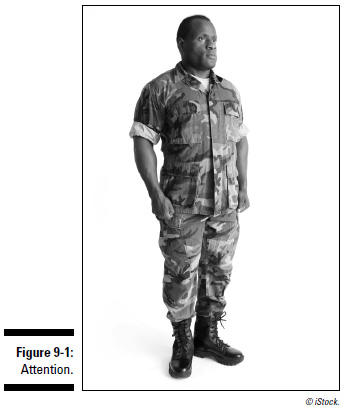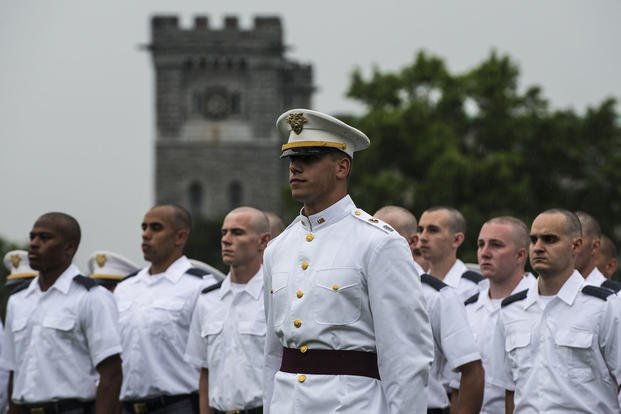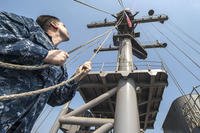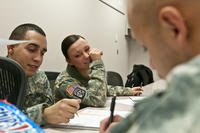Stationary drill consists of drill movements that are accomplished without marching. The drill positions of attention and parade rest are two perfect examples. Other stationary drill commands include parade rest, at ease, left (or right) face, about face and fall out. Some commands, such as present arms and order arms, can be accomplished while moving or while stationary.
Warning: If you don't remember anything else, do not forget to unlock your knees when you're participating in stationary drill. Bend your knees just enough so that it is not visible that you're doing so but enough to allow the blood to flow smoothly through your legs. Failing to unlock your knees will impede the blood flow to your brain so that, after a time (and you will find that stationary drill in the military often requires you to stand still for long periods), you'll grow faint and pass out. It's not a pleasant experience to suddenly find yourself abruptly kissing the asphalt of a parade grinder or the steel of a ship's deck.
Attention
To come to the position of attention (see Figure 9-1), bring the heels together smartly (by moving the left foot only) and on line. Place the heels as near each other as the conformation of the body permits and ensure that the feet are turned out equally, forming a 45-degree angle. Keep the legs straight without stiffening or locking the knees. The body is erect with hips level, chest lifted, back arched, and shoulders square and even.
 |
Arms hang straight down alongside the body without stiffness, and the wrists are straight with the forearms. Place thumbs, which are resting along the first joint of the forefinger, along the seams of the trousers or sides of the skirt. Hands are cupped (but not clenched as a fist) with palms facing the leg. The head is kept erect and held straight to the front with the chin drawn in slightly so that the axis of the head and neck is vertical; eyes are to the front, with the line of sight parallel to the ground. The weight of the body rests equally on the heels and balls of both feet, and silence and immobility are required.
Remember: To resume the position of attention from any of the rests (except fall out), the command is Flight/Squadron/Group, (group name). Attention. On the preparatory command of Flight, or Squadron, or Group, the individuals assume the position of parade rest. At the command "Attention," assume the position of attention.
Parade rest
This command can be given only when the formation is at the position of attention.
The Preparatory Command is "Parade," and the Command of Execution is "Rest." On the command "Rest," the recruit will raise the left foot just enough to clear the ground and move it smartly to the left so that the heels are 10 inches apart, as measured from the inside of the heels. Keep the legs straight, but not stiff, and the heels on line. As the left foot moves, bring the arms, fully extended, to the back of the body, uncupping the hands in the process, and extend and join the fingers, pointing them toward the ground. The palms will face outward. Place the right hand in the palm of the left, right thumb over the left, to form an X. Keep head and eyes straight ahead and remain silent and immobile.
At ease
The command is "At ease." On the command, you may relax in a standing position, but you must keep your right foot in place. Your position in the formation will not change, and silence will be maintained. Your arms may be relaxed, but your thumbs must also stay interlaced.
Fall out
The command is "Fall out." On the command, you may relax in a standing position or break ranks (move a few steps out of formation). You must remain in the immediate area and return to the formation on the command "Fall in." Moderate speech is permitted.
Right (or left) face
This command can be given only when the formation is at the position of attention.
The commands are "Right face" or "Left face." On the command "Face," raise the right (left) toe and left (right) heel slightly and pivot 90 degrees to the right (left) on the ball of the left (right) foot and the heel of the right (left) foot, assisted by slight pressure on the ball of the left (right) foot. Keep legs bent naturally, not stiff. The upper portion of the body remains at attention. This completes count 1 of the movement. Next, bring the left (right) foot smartly forward, ensuring that your heels are together and on line. Feet should now be forming a 45-degree angle, which means the position of attention has been resumed. This step completes count 2 of the movement.
About face
This command can be given only when the formation is at the position of attention.
The command is "About, face." On the command "Face," lift the right foot from the hip just enough to clear the ground. While naturally bending the knees, place the ball of the right foot approximately half a shoe length behind and slightly to the left of the heel. Distribute the weight of the body on the ball of the right foot and the heel of the left foot. Keep both legs straight but not stiff. The position of the foot has not changed. This step completes the first part of the movement. Keeping the upper portion of the body at the position of attention, pivot 180 degrees to the right on the ball of the right foot and heel of the left foot, with a twisting motion from the hips. Suspend arm swing during the movement and remain as though at attention. On completion of the pivot, heels should be together and in line and feet should form a 45-degree angle. The entire body is now at the position of attention.
Hand salute
The command is "Hand, salute." On the command "Salute," you raise the right hand smartly in the most direct manner while at the same time extending and joining the fingers. Keep the palm flat and facing the body. Place the thumb along the forefingers, keeping the palm flat and forming a straight line between the fingertips and elbows. Tilt the palm slightly toward the face. Hold the upper arm horizontal, slightly forward of the body and parallel to the ground. Ensure that the tip of the right forefinger touches headgear to the right of the right eye. If wearing a nonbilled hat, ensure that the index finger touches the outside corner of the right eyebrow or the front corner of glasses. The rest of the body will remain at the position of attention.
Warning: This procedure is used (in some of the branches) for training purposes only. This command is not usually used in actual military ceremonies.
Present arms and order arms
This procedure can be performed both during stationary drill and while marching.
When not under arms (carrying a rifle), the commands are "Present, arms" and "Order arms." On the command "Present, arms," the individual executes the hand salute. Then the hand salute ends when given the command, "Order arms." When under arms, to present arms, you bring your weapon up in front of you with the trigger facing away from your body; order arms is executed by returning the weapon to your side so that the butt is resting on the floor/ground/deck next to your right foot.
From Basic Training for Dummies, copyright © 2011 by Wiley Publishing, Inc., Hoboken, New Jersey. Used by arrangement with John Wiley & Sons, Inc.
Interested in Joining the Military?
We can put you in touch with recruiters from the different military branches. Learn about the benefits of serving your country, paying for school, military career paths, and more: sign up now and hear from a recruiter near you.














